How To Repair Loose Wood Flooring
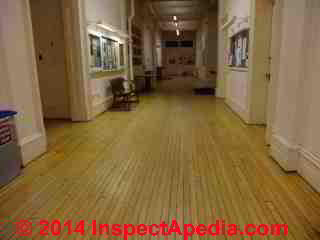 Squeaky Floorboard Repair
Squeaky Floorboard Repair
How to repair loose or noisy wood flooring
- Mail a QUESTION or Annotate most repairing wood floors that are squeaky, loose, boisterous, or noisy
InspectAPedia tolerates no conflicts of interest. We have no relationship with advertisers, products, or services discussed at this website.
Wood floor noise or loose board repairs: this commodity describes repair procedures for woods flooring that is loose, noisy, squeaky, bouncy or otherwise getting on your nerves.
We explain the steps in repairing loose noisy floor from above or from below, describing the use of nails, glues, screws, wedges, or additions back up, depending on what'south needed and what access is possible. Shown at page top, an older wood floor in Rockefeller Hall, Vassar College - DF.
Nosotros also provide an ARTICLE Alphabetize for this topic, or yous can try the page top or bottom SEARCH BOX as a quick style to find information yous demand.
Loose or Squeaky Floorboard Diagnosis & Repair Suggestions
 Reader Question: 3/23/2014 Nick Ellicott City said:
Reader Question: 3/23/2014 Nick Ellicott City said:
The floors I need help with take loose boards, gap at the pinnacle footstep tread and the business firm doesn't accept air conditioning.
The floors were laid in 1939. Would sub flooring have been laid this long ago and is that why there are loose boards and is very squeaky in places? No pet stains, no night spots should I sand or merely make full with sawdust slurry and oil.
[Click to enlarge any epitome]
OK then the "floor" nosotros show at left is a bit extreme - it'southward not actually a floor. but walking into this barn on the hay-covered flooring shown from below, I nearly killed myself stepping through the "flooring" - watch out.
Reply: use sawdust to fill wood flooring gaps?
Nick I'g unclear on what we're discussing hither, so can but make some guesses.
By 1939 many homes had wood floors installed over woods subfloor - the way to find out is to examine both sides of the floor, but 1 can also often infer or estimate or discover the floor structure just from the top surface by noticing the floor type (wideboard vs. newer solid oak or pine narrow board flooring) and by probing gaps betwixt floor boards to see if a subfloor is encountered.
The 19th century wideboard pine floor shown below was installed direct to joists.
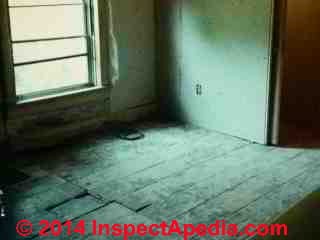
Near using sawdust to fill up forest flooring gaps
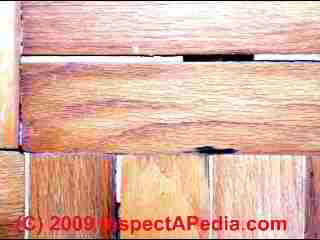 Actually? Though I understand the claim that information technology's flexible, I would non fill gaps in wood floor with sawdust and oil nor anything else, both because I'm uncertain about odor and burn down safety issues from the mixture y'all describe and considering gaps in woods floors vary in width seasonally as temperatures and moisture change. And I remember it looks ugly too.
Actually? Though I understand the claim that information technology's flexible, I would non fill gaps in wood floor with sawdust and oil nor anything else, both because I'm uncertain about odor and burn down safety issues from the mixture y'all describe and considering gaps in woods floors vary in width seasonally as temperatures and moisture change. And I remember it looks ugly too.
Filling gaps between woods floor boards invites later buckling or causes further compression of the edges of boards when they next expand. You tin see that's what's been happening with the putty-filled woods floor gaps in my parquet wood floor gap photograph at left.
When I re-finished the 1860's floor shown beneath (28 West Street, Wappingers Falls NY) I actually removed as much of the ugly yellow woods filler every bit I could, and I left gaps that were as wide as three/xvi".
Larger gaps can be a dangerous trip adventure for people wearing fasten-heeled shoes.
You tin see my "before" and "after" photos.
Nosotros put no stain on this floor. I removed old stains and debris, mitt-sanded, set loose boards, and polyurethaned the issue.
One time the poly was in place the floor was cute.
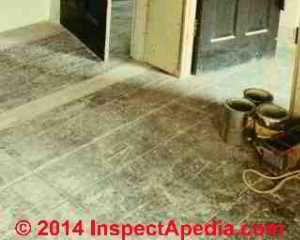

I prefer to vacuum out dirt and debris after sanding so re-finish. If gaps are and so broad equally to be a hazard, say three/16" or larger, then it might exist appropriate to cutting in a loose-fitting filler strip but that'south rarely needed except in areas of actual floor impairment. I've washed this using a wood like in grade and grain equally the original, staining it to friction match.
Meet GAPS BETWEEN Flooring BOARDS for details.
Watch out: making whatsoever gap filling repair in a wood floor invites farther compression, time to come gaps, and floor damage if the repair does non go out adequate motion space for the seasonal expansion and compression that occur in woods. How much infinite is needed? Information technology depends on the wood species, building moisture levels, and where the floor is located . For example a forest flooring over a potentially damp clamber area is going to be subject field to more moisture and more expansion.
Perhaps if I saw some sharp photograph (use the CONTACT link on our pages) I could comment more than usefully.
Follow-upward:
Thanks Dan. I volition examine the underneath and run into if at that place is subflooring. They are very squeaky in some places. Can I nail downwardly the squeaky areas? I saw the sawdust on a Youtube video. This is my first DIY project, practice yous suggest paw sanding? I also saw cleaning the floors with vinegar. The finished stain color is ideal. I don't want to do also much and ruin them. Your thoughts.
Reply: filling wood floor gaps (don't) & sanding wood floors during a restoration
I made a DIY video on how to perform micro-surgery on a cleaved ankle myself, simply I wouldn't recommend following my communication. An orthopedist will practise a amend chore. More seriously, ...
How to repair a squeaky wood floor from beneath
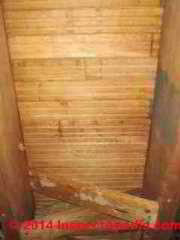 Squeaky wood floors are caused by movement in i or more than boards that rub together as you walk over them or as building temperatures and moisture level change.
Squeaky wood floors are caused by movement in i or more than boards that rub together as you walk over them or as building temperatures and moisture level change.
Kickoff by walking around to find only where the flooring is loose or squeaky. If possible likewise inspect below since what you can access and what y'all can see will assist decide how the floor can or should best be repaired.
If the flooring structure itself is bouncy you may desire to do more than just secure loose flooring boards, adding cross-bridging betwixt joists (photo at left), calculation sister joists or adding an intermediate girder or beam below.
Our photo at left shows 3/4" solid oak flooring nailed directly to the floor joists - there is no subfloor installed in this Haddonfield New Bailiwick of jersey domicile built in the 1960's.
[Click to enlarge any image]
Ideally we repair loose wood floor by screwing up or nailing-up from beneath the flooring, through the subflooring or all-time on an angle through the floor joists, through the subfloor (if present) and into the bottom 3/4 of thickness of the finish flooring higher up..
It helps to have a heavy-friend step virtually the loose board from above while nosotros're screwing up from below - to help your from-below screw pull the board downward. But encounter my foot-injury warnings beneath.
Using a wedge & polyurethane mucilage between the joist top and subflooring to placidity a noisy floor
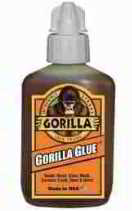 If y'all tin can access the flooring from below and see that it's the subfloor that has lifted off of a floor joist, attempt driving a sparse wedge into identify between the subfloor underside and the joist top. I put a dab of Gorilla gum on my wedge (if it'south not a historic restoration chore) knowing that the mucilage volition expand and both concur and fill the joint.
If y'all tin can access the flooring from below and see that it's the subfloor that has lifted off of a floor joist, attempt driving a sparse wedge into identify between the subfloor underside and the joist top. I put a dab of Gorilla gum on my wedge (if it'south not a historic restoration chore) knowing that the mucilage volition expand and both concur and fill the joint.
I do NOT drive the wedge tight into the gap I leave it loose but mucilage-coated - avoiding the risk of accidentally separating the subfloor from the joist top still further - making problems worse.
Tips for Working with Gorilla Glue or other Polyurethanes
Allow the expanding polyurethane glue practice the work. Let the glue dry out to its expanded foamy yellow state. If y'all need to make clean mucilage off of a finished woods floor surface, odorless paint thinner can dissolve this gum before it has cured. When it's hardened it'due south like shooting fish in a barrel to cut away excess glue but trying to work on the glue when information technology'due south still wet is a mess that you'll never go off of your skin.
If the wood is very dry I wipe my wedge with a slightly damp rag before gluing, increasing the expansion rate of the gum.
Sometimes we tin inject some glue into a sub-floor space itself before screwing down. If you utilize an expanding polyurethane glue like Gorilla Glue™, the combination of that expansion + screwing will tranquility downwards most troublesome boards.
Don't buy a large container of polyurethane glue to fix a small problem. I discover it doesn't go on.
Alternatively, for some floor board squeaks experts suggest shooting a bit of graphite powder into the squeaking joint. I'm non a fan of blowing graphite around but for ane or ii modest repairs you lot might give information technology a try.
Adding back up below squeaky loose flooring boards
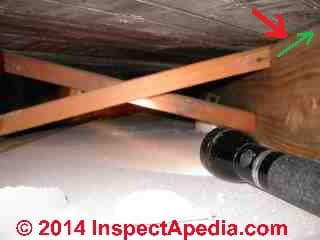 at left I'm inspecting the under-side and framing of an older floor (no subflooring) nailed right to the floor joists. You'll detect the cross bracing, merely bank check out the ruby arrow - I'm pointing to a spot where the flooring was lifted off of the joist top.
at left I'm inspecting the under-side and framing of an older floor (no subflooring) nailed right to the floor joists. You'll detect the cross bracing, merely bank check out the ruby arrow - I'm pointing to a spot where the flooring was lifted off of the joist top.
IF we tin't pull this flooring downwards to stabilize it with screws driven forth the line of my green arrow from below we'll attempt using an expanding gum.
The mucilage will both bond and make full the gap between joist pinnacle and floor under-side without making things worse past actually pushing the floor up nonetheless further - every bit yous might do if you over-drive a wedge.
Cheers to the cross bracing, even though these 2x8 joists were rather modest in dimension, this flooring was not bouncy, just squeaky.
On a very sometime floor where no subflooring is in place nosotros smash through the flooring joist top or if there is a "floating" butt joint between two boards non ending over a joist we may screw up a iii/4" or thicker solid plywood plate to the underside of the floor (if a broad area of support is needed) or best we boom 2x lumber of the same depth (or less) every bit the floor joists, every bit a block between flooring joists.
Locate the cake below the squeakiest department of floor and screw upwards through the top edge of the blocking into the subfloor and floor.
For a horribly noisy wood floor y'all may need to add multiple blocks between the joists, placing blocking about 4 feet on eye and nailed into opposing joists.
Watch out: for directly-up support plate repairs to a loose or squeaky wood floor be sure to apply screws that are short enough as not to beetle through the finish floor surface above, after allowing for any depth to which the screw volition sink into the underside of the board as y'all tighten it.
Do we employ finishing nails, band-shank nails or screws to secure a loose floor lath?
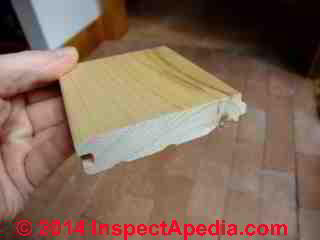 Usually screws work meliorate than nails to secure loose floor, especially when repairing the floor from below.
Usually screws work meliorate than nails to secure loose floor, especially when repairing the floor from below.
The screw tin can pull down a board while nailing information technology may have less satisfactory results.
If the thickness of the finished floor is less than about v/16" in thickness, working on an bending and with intendance you may still accept success but there's a good adventure that your screws from below are not likely to hold.
The forest flooring at left is three/four" thick solid hickory - plenty of thickness to concur a spiral from beneath, merely this woods is so hard that if yous are repairing it from to a higher place you lot'll need to pre-drill holes.
Watch out: don't use more than nails or screws than necessary or you may impairment the board or even make things worse.
Sentry out: don't drill a screw up through the finished flooring or worse screw your friend's foot to the floor above.
How to repair a loose or squeaky forest floor from in a higher place
If nosotros cannot access the loose, squeaky floor from below (considering the neighbor won't let us in or because in that location is a concrete structure or expensive ceiling in the way) we can still secure the squeaky or loose floor from above, driving trim screws or larger screws on an appropriate angle to pull the loose board downwards and snug it upwards.
Should you lot apply nails or screws? If the board is loose but not hard to pull downwards, using 6d stainless band-shank nails driven through a pre-drilled (smaller bit than nail) hole may work all-time and will allow you to counter-sink the nail head at least 1/8" below the flooring surface.
For floor boards that are hard to pull downwardly by nailing screws may be more than effective.
What near those ugly spiral heads in the repaired floor? For a more cosmetically perfect wood floor repair nosotros sometimes use a very sharp gouge to elevator a fleck of floor off of the surface without breaking the forest-scrap away. Then we drive and counter-sink our spiral (or nail) in the depression provided by the gouge. When the fastener has been counter-sunk we glue the raised gouge back down.
An alternative to the flooring repair using the "lift-a-bit" method is to drill out and countersink screws, filling the hole with a matched plug sanded and stained to exist unobtrusive. I'm non a fan of this arroyo unless nosotros are going to be installing a regular and attractive pattern of plugs in the flooring and I'd avert information technology entirely on a historic and valuable woods floor.
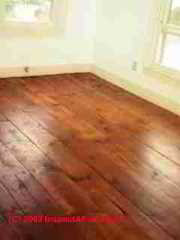 I use a bit of waxed paper atop the floor gouge and weigh it down with a apartment chunk of iron nosotros keep around for that purpose. When the glue is dry the waxed paper lets me lift away the weight and if necessary remove whatever excess glue that seeped out of the repair. This process can make a nearly-invisible repair in even a fine woods floor.
I use a bit of waxed paper atop the floor gouge and weigh it down with a apartment chunk of iron nosotros keep around for that purpose. When the glue is dry the waxed paper lets me lift away the weight and if necessary remove whatever excess glue that seeped out of the repair. This process can make a nearly-invisible repair in even a fine woods floor.
Sanding old wood floors: communication
About hand sanding versus power sanding, the answer is, as Marker Cramer says, ... it depends.
On a hardwood floor with plenty of wood thickness and deep damage we might employ a power sander along with an edger.
On an antique (often soft-forest) flooring like the 1 shown at left we use a combination of sharp manus scrapers and mitt sanding. In my opinion sanding an antique or historic floor dead apartment produces a weird and inappropriate finish.
In full general using the least subversive, least invasive method is best.
The floor shown hither was antiquarian wide pine board with ship-lap joints that had been installed around 1860. We discuss information technology further and include a "earlier" photo
at Floor WOOD Historic period TYPES HISTORY
Reader Comments & Q&A
@Ann Hughes,
I don't dearest my solution but don't know one ameliorate:
In the center of the squeeking area of the flooring, utilise a caulk gun to inject a blob of articulate silicone sealant - you don't need to fill the whole area, just squeeze in enough to brand an estimated hulk size of an inch or two in diameter.
Then wipe off the excess sealant using a damp cloth, leaving your one/8" pigsty filled flush (or if you want to get fancy, recessed so you can fill it with an attempted match to the original floor). I think you'll find the hole barely noticeable.
So stay OFF of the floor in that expanse for at least 24 hours; 48 hours would be amend because in my experience squirting silicone sealant into a tightly-closed space with piddling air tin can take longer than normal to harden.
Y'all could besides apply an expanding polyurethane glue similar Gorilla mucilage that would work well, only you'll demand to have a bit of odorless paint thinner on mitt to clean up the over-spill: it's messier and harder to make clean than silicone sealant and I worry that you could foul up the flooring's surface terminate, that's why I suggested the silicone sealant instead.
If you decide to use polyurethane, which has the reward of expanding into the open space below the floor, you'll desire to use bluish masking tape over the insertion hole during curing or glue will continue to ooze back up out of the insertion opening as it cures.
I have an engineered wood floor all through my footing floor. At that place is a 3ft square patch simply as you footstep off the last stair where the sub floor seems to be damaged as the boards are squeeking and dropping when you stand on them.
This is merely a small patch and I do not want to have to replace the whole hall area for such a minor slice.
Can you give me some advice as to what would exist the best course of activity. I understand that the woods has been nailed and glued. ?
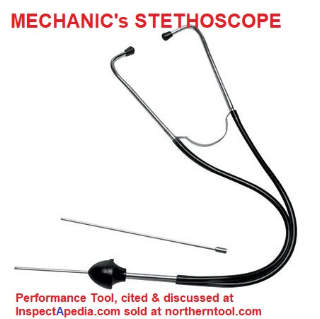 Sure Sharon. A mechanics's stethoscope is in essence a doctor's stethoscope merely the round disc that amplifies sound is replaced by a solid steel rod. The tip of the rod is pressed confronting diverse surfaces to see where audio seems loudest. A mechanic uses the device to locate a bad bearing or other engine dissonance.
Sure Sharon. A mechanics's stethoscope is in essence a doctor's stethoscope merely the round disc that amplifies sound is replaced by a solid steel rod. The tip of the rod is pressed confronting diverse surfaces to see where audio seems loudest. A mechanic uses the device to locate a bad bearing or other engine dissonance.
Yous can find these at your local automobile parts store or at Walmart or online, or you lot could make your own if you have a medical stethoscope at hand.
Here's an example since Comments box lost our earlier paradigm
Cheers so much for your respond.
I will attempt a mechanic's stethoscope, which no one else suggested and which was unknown to me. I appreciate your knowledge and your sharing of it.
Your engineers guess is probably the best i from what you take told me. There are company specializing in noise assay and diagnosis though I am not sure that it would be cost Justified for the situation.
Or you lot could try listening more carefully with a mechanic'due south stethoscope to narrow downwards the specific edifice components that are moving. Off of what people exercise is identify the nearly probable culprit and effort to brand some changes that will prove that that was the source when the noise abate'due south.
The Apr twenty 2022 answer to Judith said "one would want a confident and accurate diagnosis of the cause of the trouble". Ceilings and maybe walls in two bedrooms of my house have borer and banging noises day and dark, sometimes at well-nigh 1/2 hr intervals.
The structural engineer saw no cracks anywhere and said it was probably caused by the flat roof and New Mexico temperature variations and 24-hour interval/dark problems. The carpet guy tacked down some screws where the floor seemed to accept movement. The HVAC man balanced the condenser on the roof. The racket persists. Who should I inquire for a diagnosis?
Judith before assigning responsibility for who shouuld do what one would want a confident and accurate diagnosis of the cause of the problem you describe.
I hold that water or high wet in a crawl infinite can exist a problem in a home and in my OPINION is itself unacceptable.
Simply there are other causes for flooring damage including installation mistake - depending on the flooring type, materials, subfloor, etc.
2 year former home encapsulated in clamber space our hardwood floors pop all over should the builder replace the flooring
...
Continue reading at Flooring NOISES in BUILDINGS or select a topic from the closely-related articles beneath, or run across the consummate ARTICLE INDEX.
Or see these
Recommended Articles
- FLOOR Racket CONTROL
- Floor Woods AGE TYPES HISTORY - dwelling house
- Floor NOISES in BUILDINGS - topic domicile
- WOOD FLOOR DAMAGE REPAIR - home
Likewise see Mike Litchfield's RENOVATION 4th EDITION: Completely Revised and Updated, [Book sold via Amazon] Taunton Press; quaternary ed. (2012), ISBN-10: 1600854923 ISBN-13: 978-1600854927.
Suggested commendation for this web folio
LOOSE NOISY Flooring REPAIR at InspectApedia.com - online encyclopedia of building & environmental inspection, testing, diagnosis, repair, & problem prevention advice.
Or come across this
Alphabetize to RELATED ARTICLES: Article Index to BUILDING Flooring
Or use the SEARCH BOX found below to Ask a Question or Search InspectApedia
...
Ask a Question or Search InspectApedia
Endeavour the search box simply beneath, or if you prefer, mail service a question or comment in the Comments box below and nosotros volition respond promptly.
Search the InspectApedia website
Note: appearance of your Annotate below may be delayed: if your comment contains an image, web link, or text that looks to the software as if it might be a web link, your posting will appear after it has been approved by a moderator. Apologies for the filibuster. Our Comment Box is provided by Countable Web Productions countable.ca
Technical Reviewers & References
Click to Show or Hide Citations & References
Publisher InspectApedia.com - Daniel Friedman
Source: https://inspectapedia.com/interiors/Noisy_Floor_Repair.php

0 Response to "How To Repair Loose Wood Flooring"
Post a Comment